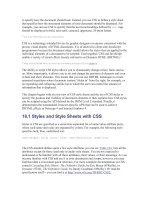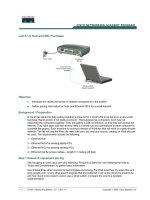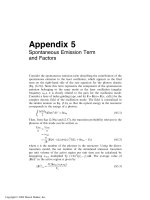MOB Subject 5 –Access methods Static and dynamic access techniques
Bạn đang xem bản rút gọn của tài liệu. Xem và tải ngay bản đầy đủ của tài liệu tại đây (330.56 KB, 12 trang )
Master of Computer Science 1 - MOB Mobile Internet and Surrounding
1/12 Baey, Fladenmuller – Subject 5
MOB Subject 5 –Access methods
Static and dynamic access techniques
1. Static access techniques
1.1 Space-division multiple-access (SDMA)
When one seeks to cover a broad territory by a whole of cells of the same dimension, one
considers that the traffic is uniformly distributed, that the propagation law is the same and that the
power of all the equipment is constant. The same number of carrier will have thus to be allocated to
each basic station.
One will often use a hexagonal paving to cut out the zone has to cover, the hexagon being the
polygon nearest to the circle which allows paving the plan. One calls cluster, a set of adjacent cells
which uses the unit of carriers one and only one time. This cluster is repeated on all surface has to
cover.
Arithmetic and geometrical considerations allow showing that a cluster having a given number
of carrier is optimal if it is regular. For a hexagonal paving, the size K of cluster verifies the relation:
K = i
2
+ ij + j
2
(1)
with i and j entries positive natural or null.
The paving of the zone has to cover is realized of iterative manner in leaving of a cluster given
of K cells. From one cells of this cluster, one moves vertically i cells to one of its sides, then j cells
in a direction forming an angle of +60 degrees with the initial direction. The arrival point defines
then the "homologous" cell of adjacent cluster. By repeating this process for the set of cells of the
cluster chosen at the origin while keeping these same directions, one defines an adjacent cluster.
One repeats then this process for the five other possible directions (other dimensions of the cell) to
find the set of adjacent clusters. In proceeding secondly little by little on the cluster, one then builds
a paving of the cover zone.
Each cell of a cluster is seen allocated a subset of the carrier which is own for it. The homologous
cells of all the cluster use the same carrier. The minimal distance between two cells (homologous)
using the same carrier is called reuse distance. The size K of the cluster also constitutes the reuse
factor of the carrier.
1. What is the principle of the reuse of frequencies in the domain of the cellular networks?
In a cellular network, the space is divided into cells, each served by a base station (i.e a cell is
a portion of the territory covered by a base station).
It was affecting to each cell (i.e at each base station), a number of carriers of the total
bandwidth available based on estimated traffic in this cell.
It is possible to reuse one even at the same carrier in different cells if they are sufficiently
remote. The reuse of frequencies thus allows an operator has to cover an unlimited
geographic area by using a frequency band width limited.
2. Discuss the advantages and disadvantages to use of cells of small size, in comparing with
cells of big size in the cellular networks.
Advantages:
- greater reuse of frequencies: optimization of bandwidth;
- increase battery life because the power of emission decreases;
Master of Computer Science 1 - MOB Mobile Internet and Surrounding
2/12 Baey, Fladenmuller – Subject 5
- if a cell is malfunctioning or cluttered, possibility to switch to a neighboring cell.
Disadvantages:
- Roaming Management heavier if mobility;
- Increasing the level of interference between cells.
3. List several manners to increase the capacity of a cellular network:
- Adding new carriers: usually when a system is implemented in a region, all carriers are not
used. Growth can then be managed using these carriers.
- Borrowing frequency: in the simplest case, cells are over-used carrier will temporarily
borrow the adjacent sub-cells used. The carriers may also be dynamically allocated to cells.
- The severing of cells: in practice, the traffic distribution and extent dansune cell are not
uniform. The cells can be very busy subdivided into smaller cells.
- Sectorized cells: this is to divide the cell into sectors, each possessing its own set of
carriers. Typically we can consider three or six sectors per cell. Each sector is assigned a
distinct subset of carriers. Directional antennas at the access points or base stations are used
to concentrate the signal in the region of the sector and reduce the interference and
"inter-sector".
- Microcells: for cellular networks with larger cells, the antennas must be placed on top of
hills or tall buildings. When cells become smaller, the antennae can be placed on buildings or
even less high peaks of the streetlights. The reduction of cell size accompanied by a
reduction of the power radiated by both points of access by mobile devices. The microcells
may be used in congested areas, such as certain city streets, highways, the interior of large
public buildings ...
4. Factor of reuse K.
a) Give the first entries which verify the equation (1). What do these values of K
correspond to?
i j K
1 0 1
1 1 3
2 0 4
2 1 7
3 0 9
2 2 12
3 1 13
4 0 16
3 2 19
4 1 21
5 0 25
The first K values are: 1, 3, 4, 7, 9, 12, 13, 16, 19, 21, 25, ... These values correspond
to the sizes of possible reasons.
b) Show on the figure 1 the cluster for reuse for K = 19.
Master of Computer Science 1 - MOB Mobile Internet and Surrounding
3/12 Baey, Fladenmuller – Subject 5
Figure 1: Hexagonal clusters
Figure 2: Hexagonal clusters with K = 19
Figure 3: Hexagonal clusters with K = 3
5. An analog cellular system has 33 MHz of band-width and uses two channels simplex of 25
kHz to provide a transfer service of full-duplex trace and the indication necessary.
a) What is the number of full-duplex channels available by cell for a reuse factor K = 4, K =
7, K = 12?
The number of available channels is N = 33,000 / 50 = 660.
For a frequency reuse factor of K, each cell has N
cel
= N / K full-duplex channels
With K = 4, N
cel
= N / K = 660 / 4 = 165 full-duplex channels
Master of Computer Science 1 - MOB Mobile Internet and Surrounding
4/12 Baey, Fladenmuller – Subject 5
With K = 7, N
cel
= N / K = 660 / 7 = 94 full-duplex channels
With K = 12, N
cel
= N / K = 660 / 12 = 55 full-duplex channels
b) If one supposes that 1 MHz is dedicated to the control channels and that only a control
channel is necessary by cluster, determine a reasonable distribution of the voice channels
for each cell, for the 3 reuse factors given previously.
32 MHz are dedicated to voice traffic, a total of 640 full-duplex channels.
For K = 4, we can have 160 voice channels (4 160 = 640).
For K = 7 then 640 / 7 = 91,4 which is not an integer. It then looks for x number of cells
with 91 voice channels and y the number of cells with 92 voice channels. One solves the
system of equations has two unknowns: x 91 + y 92 = 640 and x + y = 7.
We get x = 4 and y = 3.
We can have 4 cells with 91 voice channels and 3 cells with 92 voice channels, remember
(4 91 + 3 92 = 640).
For K = 12, we can have 8 cells with 53 voice channels and 4 cells with 54 voice channels
(8 53 + 4 54 = 640)
1.2 Frequency-division multiple access (FDMA)
1. A cellular system uses the FDMA, with a spectrum allocation of 12,5 MHz in each direction,
a guard band of 10 kHz of each end of the allocation spectrum and a width of 30 kHz for
each channel. Which number of users can one have in maximum?
416
1030
)1010(2105,12
3
36
2. The spectral efficacy of the FDMA for a cellular system is defined by: with
B
c
the band-width of the channel, N
T
the total number of trace channels in the covered zone,
and B
w
the band-width in a direction. What is the maximum limit of η
a
?
The amount of bandwidth allocated to voice channels (BcNt) must be no greater than the
total bandwidth (Bw). Therefore η
a
1.
1.3 Time Division Multiple Access (TDMA)
In the traditional local networks, a physical support is sharing between several users. It is thus
important to define the access rules of the media for the frames emission. Two families of solutions
are possible: the static solutions and the dynamic solutions.
1. Let a network be constituted of N connected stations on the same support. Let T be the average
stay time of a frame expressed in seconds, C the channel capacity in bits per second and M the
arrival rate of frames on the channel, expresses in frames per second. It is supposed that the
inter-arrival distribution of frames is exponential. The size of a frame is distributed according
to an exponential law, of average L bits. The digital values of these parameters are C = 64 kbits,
M = 10, L = 4 kbits.
a) What is the value of T?
To calculate the average time of stay, we consider a system has queue. The
frames of the stations are served one after the other in their order of arrival (FIFO
Master of Computer Science 1 - MOB Mobile Internet and Surrounding
5/12 Baey, Fladenmuller – Subject 5
discipline). It has a single server.
Each frame with a size distributed according to an exponential distribution and the
capacity of the channel being constant service time of a frame has an exponential
distribution of average L/C or rate = C/L.
Finally, the distribution is exponential interarrivals frames, rate = M.
It was therefore a M/M/1 queue. The theory of the waiting can calculate the average
time of stay:
T =
1
T =
M
L
C
1
T =
s
6
1
10
4
64
1
b) The channel is divided in static way of N sub channels independent. The traffic of the
stations is distributed in a uniform way on these various sub channels. What becomes
the average stay time of a frame?
Each sub-channel has a capacity of C / N bits per second. The service time of a frame
has an exponential distribution of average L / (C / N), or rate = C / (N L).
The distribution of inter-arrivals frames on each sub channel is exponential, rate =
M/N.
The average residence time is identical on each sub-channels. Using the model has
M/M/1 queue, we obtain:
s
M
L
C
N
N
M
LN
C
T
static
6
4
10
4
64
41
c) What do you deduce from?
For multiplexing static, the average time of stay T is N times greater than if all the
frames had been ordered, as in a single queue using the single channel globally. The
static solutions are simple to introduce, but suffer from a very low yield. You lose the
multiplexing gain!
3. Dynamic access techniques
Pure Aloha: the principle of Aloha is to let talk to everyone when he wants it and without discrete
the moments when one can start to emit.
Discrete Aloha: the principle is the same but with a discrete time i.e. the moments when one can
start to emit are spaced out.
CSMA (Carrier Sense Multiple Access): CSMA protocols used in the wire networks allow to
improve the output of the ALOHA protocol because they bring the certainty that the stations
will be careful not to emit if they note that another station is emitting. Another improvement









